Sphinginae subfamily
Sphingini tribe:
 |
Manduca quinquemaculatus,
USGS the Five-spotted Hawkmoth:
Abdomen: five or sometimes six pairs of yellow bands. Fw upperside blurry brown and gray.
Hw upperside banded with brown and white; two well-separated median zigzag bands. Fw fringes grayish, not distinctly spotted with white.
Larvae feed on tomatoes. |
 |
Sphinx chersis WO, the Northern Ash Sphinx or Great Ash Sphinx
The upperside of the forewing is soft dark gray to blue-gray with
a series of black dashes, one of which reaches the wing tip. It is questionable for Columbia; more westerly. |
 |
Sphinx drupiferarum
WO,
the Wild Cherry Sphinx
The forewing is dull slate grey with considerable light grey scaling in a broad band along the costa about 3/4 of distance from body toward the apex. Median
lines are black and thin.
There is a Wavy, diffuse dark subterminal line, inwardly bordered by white, and a whitish bar in terminal area, paralleling outer margin.
|
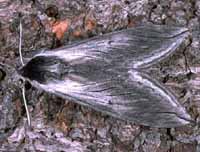 | The upperside of the forewing is dark grey to black with a
paler costa and pale area from the base to the wing's centre.
Prefered habitats include montane woodlands and mixed chaparral-type
vegetation. |
 |
The upperside of the forewing has a narrow black subterminal line
bordered by a white inverted V-shaped line on the outside, and a
black line running inwards from the apex of the wing.
It is most often found in montane woodlands and along streamcourses. |
Smerinthini Tribe:
 |
Pachysphinx modesta WO,
the Modest Sphinx or Poplar Sphinx,
This large poplar/willow feeder is probably quite common in Walla Walla.
They are a heavy bodied species.
|
 |
This one is quite similar to Pachysphinx modesta, with modesta
being smaller and darker.
If you've got willows or poplars nearby, then you probably have
occidentalis in your immediate area.
|
 |
The grey-blue eyespot of the hindwing gives this species its name.
Larvae feed on birches, willows, cherries and oaks.
The outer edge of the forewings is quite scalloped. |
 |
This small species is probably widespread and common. This species
ranges across North America.
The hindwings have a small blue eyespot ringed with black on a yellow
background.
|
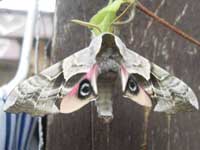 | Larvae feed on poplars, aspen and willows.
Note different shape of double arced forewing pm line compared to the straighter pm line of cerisyi, which it replaces in WA.
S. ophthalmica has smoother scalloping of the fw outer margin.
|
Macroglossinae subfamily
Dilophonotini tribe
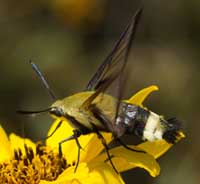 |
Hemaris thetis is a very variable species, but almost always the abdomen sports contrasting black and
yellow hairs, the ventral surface being quite black. The legs also tend to be quite dark and there is a black mask
running across the eye and along the sides of the thorax.
|
Macroglossini tribe
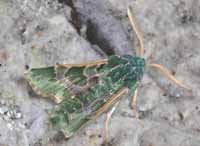 |
Arctonotus lucidus
WO, the Pacific Green
Sphinx Moth or Bear Sphinx These moths have a short, stout body. The upperside of the forewing is green to olive green with pink and brown markings.
The upperside of the hindwing is pale rose pink with a darker submarginal band. |
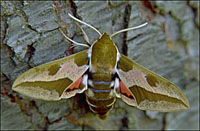 |
Hyles euphorbiae
WO, the Spurge Hawk Moth
The body is light brown with various white and dark brown
markings, while the wings have a conspicuous tan, brown, and pink or
red color pattern. It is not yet confirmed for this county, but is expanding its range
and will probably soon be reported.
|
 |
Hyles gallii WO,
the Bedstraw Hawk Moth or Gallium Sphinx
The forewing is dark brown with a slightly irregular cream-coloured transverse line. The outer margin is grey.
There is a bright pink band on the hindwing. If you have
Gallium or Epilobium, you probably have populations of
this species. |
 |
Hyles lineata WO, the White-lined
Sphinx
This species is very widespread. It can be seen flying during the day, into the evening and also at night.
The highly variable larvae are often found in people's gardens.
|
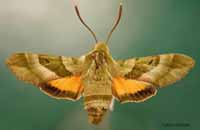 |
The upperside of the forewing is greenish gray; the median area may be dark or pale. The upperside of the hindwing is bright orangish yellow with black borders.
This day flier, April-June, prefers oak woodland and pine-oak woodland in
foothills. Moths nectar at a variety of flowers in the afternoon.
|
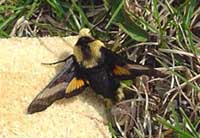 |
Proserpinus flavofasciata WO,
the Yellow-banded Day Sphinx:
The forewing upperside is medium to dark brown with a faint to distinct white median band. The upperside of the hindwing is
dark brown with a wide orange median band which may not reach the inner margin. The moth mimics a bumblebee.
It nectars during the day in meadows near coniferous forests. |
|
|
